From its invention, photography has been a medium that was prized for its ability to capture what we see in flawless detail, freezing more of "reality" than could ever be absorbed by our limited visual perceptions. Without special forethought, my photography has tended toward images that celebrate the beautiful detail of the natural world. I have tried to use the remarkable powers of digital photography and editing to place viewers in locations as I have seen them, working to display the mood as well as the reality of the remarkable world around us. But photography has always provided a means to see things beyond our normal perceptual capacity, that are not accessible to the naked eye (THERE, I got the word "naked" into the article - TWICE! Watch my hits soar!).
Anyway, In the beginning photography captured "Reality" in its own way based on its technical limitations. It has always had the
 remarkable ability to
freeze time, not only for moments but for centuries. As initially a
black and white medium, photography washed the color from the world and
forced a new focus on light and pattern that had always been hidden
under a gaudy chromatic layer in our perception. Photography has
expanded and altered our vision in many other ways and, digital
photography, although not required for many of these advances, has made
them more easily accessible and pushed opened the door to these unseen
new worlds. I have discussed many of these techniques in much greater
detail in previous articles, but here is a brief list of some of the
ways that photography can open our eyes to a new worlds. Let the journey
begin.
remarkable ability to
freeze time, not only for moments but for centuries. As initially a
black and white medium, photography washed the color from the world and
forced a new focus on light and pattern that had always been hidden
under a gaudy chromatic layer in our perception. Photography has
expanded and altered our vision in many other ways and, digital
photography, although not required for many of these advances, has made
them more easily accessible and pushed opened the door to these unseen
new worlds. I have discussed many of these techniques in much greater
detail in previous articles, but here is a brief list of some of the
ways that photography can open our eyes to a new worlds. Let the journey
begin.
Infrared
Infrared photography is perhaps the best example of seeing the
 unseen. Infrared
is the portion of the electromagnetic spectrum beyond deep red.
Although these longer wave lengths are beyond the ability of our eyes to
detect, infrared photographs have been captured since the early
1900's. Today a digital camera can be modified to respond to the
infrared making it much easier to capture this invisible world. The
infrared spectrum shows foliage in brilliant
unseen. Infrared
is the portion of the electromagnetic spectrum beyond deep red.
Although these longer wave lengths are beyond the ability of our eyes to
detect, infrared photographs have been captured since the early
1900's. Today a digital camera can be modified to respond to the
infrared making it much easier to capture this invisible world. The
infrared spectrum shows foliage in brilliant  light, making summer scenes
appear like winter landscapes. It cuts through haze and reveals puffy
clouds in stark contrast against inky black skies. With infrared
photography it is often possible to capture powerful images on days when
the light is too flat and dull for strong conventional images. I found
it well worth the expense to modify my old Canon 20D doorstop to become
my IR camera.
light, making summer scenes
appear like winter landscapes. It cuts through haze and reveals puffy
clouds in stark contrast against inky black skies. With infrared
photography it is often possible to capture powerful images on days when
the light is too flat and dull for strong conventional images. I found
it well worth the expense to modify my old Canon 20D doorstop to become
my IR camera.For More Information:
Infrared, Seeing Photography in a Different Light
HDR
High dynamic range photography can be used to overcome the
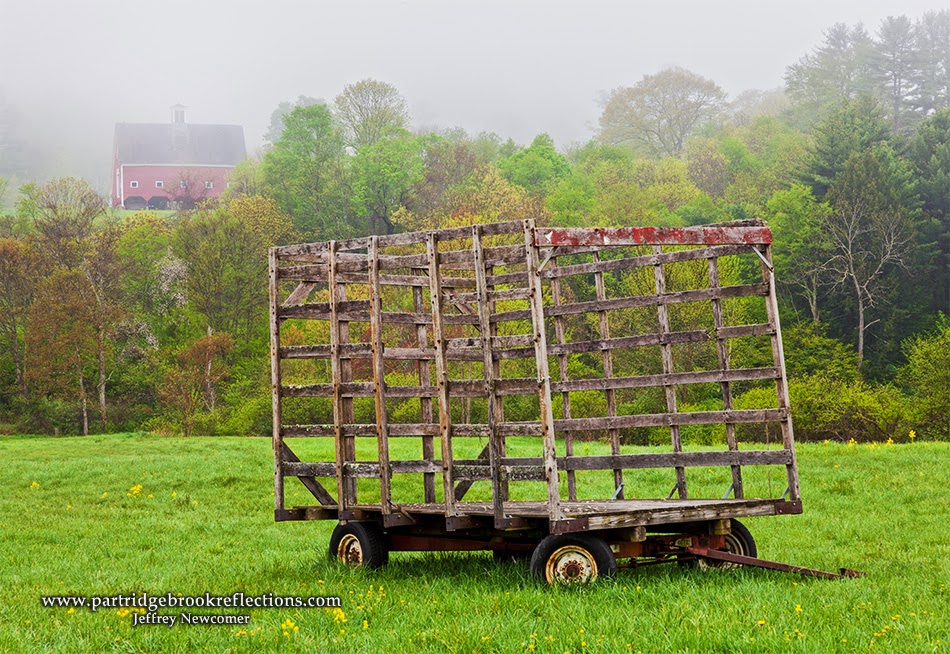 |
| Improving Dynamic Range |
turning a mirror on the artists mood and fancy rather than the reality of the moment. I love HDR because it provides such an unlimited opportunity for self-expression. I generally use these tools to render images that better reflect the dynamic range that was apparent in the field, but occasionally it is fun to go crazy, jump through the looking glass, and produce something that truly would never be apparent to the eye.
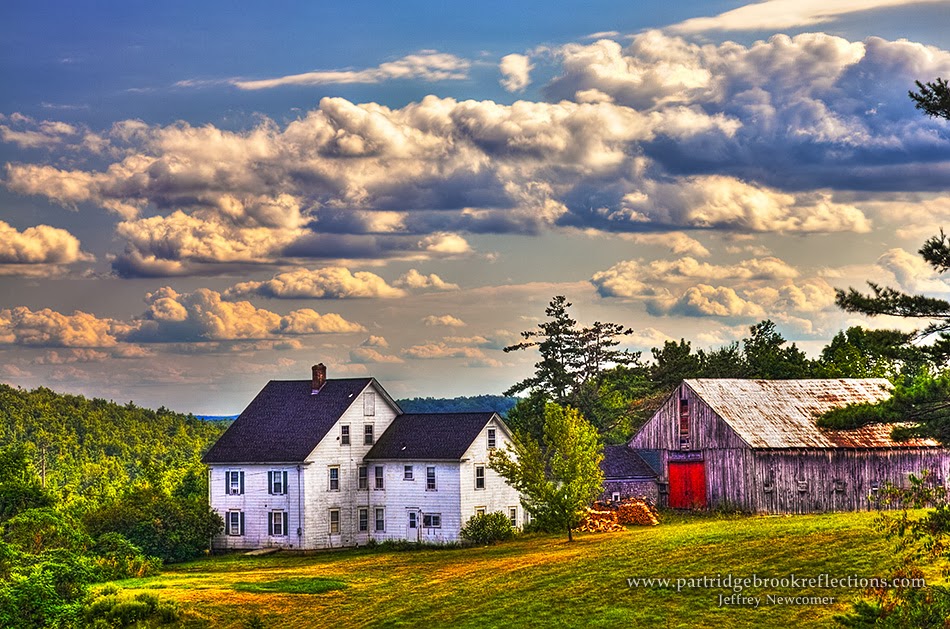 |
| Going Crazy |
For More Information:
HDR: Bon Appetitt
Taming the HDR Beast
Stop Motion:
Stopping motion requires fast shutter speeds that the high ISO
 capability of new
digital cameras has made more practical. I remember, from the ancient
past, when loading the camera with ASA 400 film was a considered
reckless, trading speed for the assumed damage to image quality. Based
on the lighting, I can now easily dial up the ISO to whatever is
required, to allow a
capability of new
digital cameras has made more practical. I remember, from the ancient
past, when loading the camera with ASA 400 film was a considered
reckless, trading speed for the assumed damage to image quality. Based
on the lighting, I can now easily dial up the ISO to whatever is
required, to allow a  shutter speed fast enough to freeze the action or
capture images in inky darkness.. The combination of the improved low
light sensitivity of new digital sensors and the capability of software
noise reduction algorithms has made it possible to maintain acceptable image quality at ridiculously high ISO levels.
shutter speed fast enough to freeze the action or
capture images in inky darkness.. The combination of the improved low
light sensitivity of new digital sensors and the capability of software
noise reduction algorithms has made it possible to maintain acceptable image quality at ridiculously high ISO levels.For More Information:
Accidental Bird Photography
Great Blue Heron on Harvey Pond
Long Exposure;
Long exposures have always been a capability of photography. In
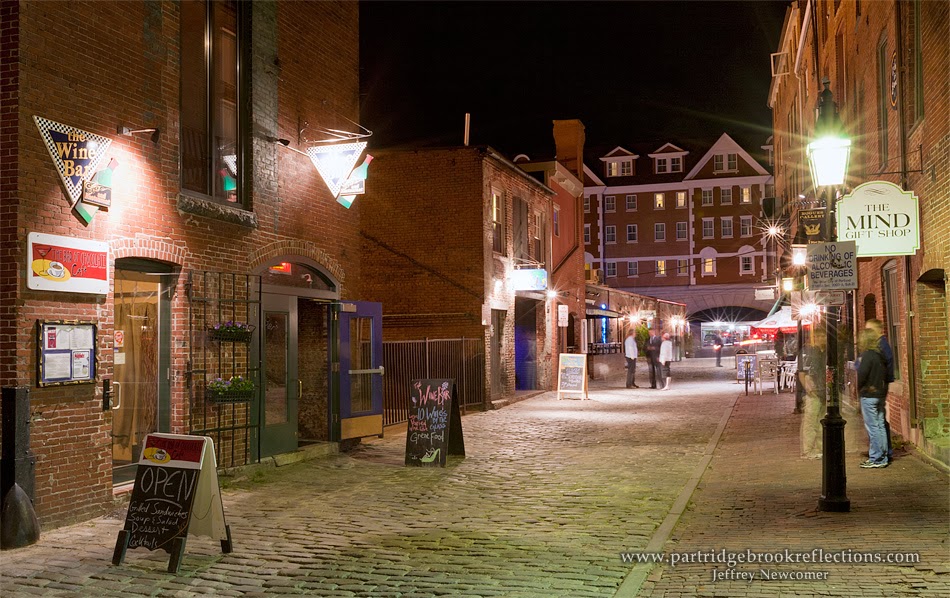 |
| Crowded Portland Street |
 or less
can transform a roaring chaotic stream into a soft dream-like
confection, looking nothing like the original scene, but providing a
sense of frozen movement. Long exposures of a busy street can remove
all the distractions of moving cars and annoying people, magically
focusing on the stationary scene. Star tract images of the night sky
transforms individual stars from points of light into majestic arcs
rotating around the north star. All of these technique are made much
simpler by the ability, in the digital camera, to immediately review the
results and adjust exposures accordingly
or less
can transform a roaring chaotic stream into a soft dream-like
confection, looking nothing like the original scene, but providing a
sense of frozen movement. Long exposures of a busy street can remove
all the distractions of moving cars and annoying people, magically
focusing on the stationary scene. Star tract images of the night sky
transforms individual stars from points of light into majestic arcs
rotating around the north star. All of these technique are made much
simpler by the ability, in the digital camera, to immediately review the
results and adjust exposures accordinglyFor More Information:
Photographing the Magic of Velvet Water
Long Exposure Crowd Control
Star Track Photography
Deep Space:
While we are talking about night sky images, I think one of the
 most
impressive ways that digital cameras have altered our sense of nighttime
wonder has come from the ability that long exposures and high ISO have
to extend our vision into deep space. ISOs ranging from 1600 to 6400 and
exposures of 20-30 seconds brings a dense sea of stars into view that
are invisible to our eyes even on the darkest night. Beyond doubt, the
celebrity of this celestial show is our own galaxy, the Milky Way. The
most impressive images usually show the Milky Way's brilliant band in
some appropriately interesting setting, and there are now many programs
and Apps that can tell us precisely when, and where to stand to place a
lighthouse, a tree or a silo in front of the show. I live in the
country and I often get a clear view of the sky, but even here the
digital camera easily converts a subtle smug into a breathtaking view of
our galactic disc.
most
impressive ways that digital cameras have altered our sense of nighttime
wonder has come from the ability that long exposures and high ISO have
to extend our vision into deep space. ISOs ranging from 1600 to 6400 and
exposures of 20-30 seconds brings a dense sea of stars into view that
are invisible to our eyes even on the darkest night. Beyond doubt, the
celebrity of this celestial show is our own galaxy, the Milky Way. The
most impressive images usually show the Milky Way's brilliant band in
some appropriately interesting setting, and there are now many programs
and Apps that can tell us precisely when, and where to stand to place a
lighthouse, a tree or a silo in front of the show. I live in the
country and I often get a clear view of the sky, but even here the
digital camera easily converts a subtle smug into a breathtaking view of
our galactic disc.For More Information
Night Time Photography, Searching for the Milky Way
Photographing Comet PanSTARRS
Time Lapse
Time lapse photography compresses time allowing us to see in a few seconds what occurred over hours. All that is necessary is a sturdy tripod, an intervalometer to time the exposures and software to assemble the hundreds of images into a video. For quick and simple time lapse videos I have used Quick Time, but many other options exist. I'm still a novice, but I have enjoyed creating videos of the setting sun, billowing clouds, or stars moving majestically across the sky. I even have one of Susan and I decorating the Christmas tree.
Monadnock Sunset
Tree Trimming
For More Information
Time Lapse Time
Focus Stacking
It may seem that the use of focus stacking to achieve a deep depth of field only replicates what our eyes can capture, but in fact eyes
 have
the same focusing limitations as any lens and iris system. The only
reason that we feel we can see everything from near to far in sharp
focus is that our eyes are constantly and subconsciously adjusting focus
as we move our attention around the scene. A photograph with sharp
focus throughout is actually a representation of the world beyond the
capability of our vision, but it does match the dynamic nature of our
perception.
have
the same focusing limitations as any lens and iris system. The only
reason that we feel we can see everything from near to far in sharp
focus is that our eyes are constantly and subconsciously adjusting focus
as we move our attention around the scene. A photograph with sharp
focus throughout is actually a representation of the world beyond the
capability of our vision, but it does match the dynamic nature of our
perception.For More Information:
Focus I
Focus II
Hand-Held Focus Stacking
Of course there are more ways that digital photography allows us to see the unseen. Editing software can alter our vision and a world without a tangle of wires in front of every beautiful scene is a priceless gift of Photoshop. It has been thrilling to explore some of the photographic options available, but It is also humbling to realize all that I need to learn. But then again the endless opportunities to learn are what make photography endlessly exciting.
Jeffrey Newcomer
Partridgebrookreflections.com
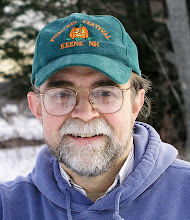
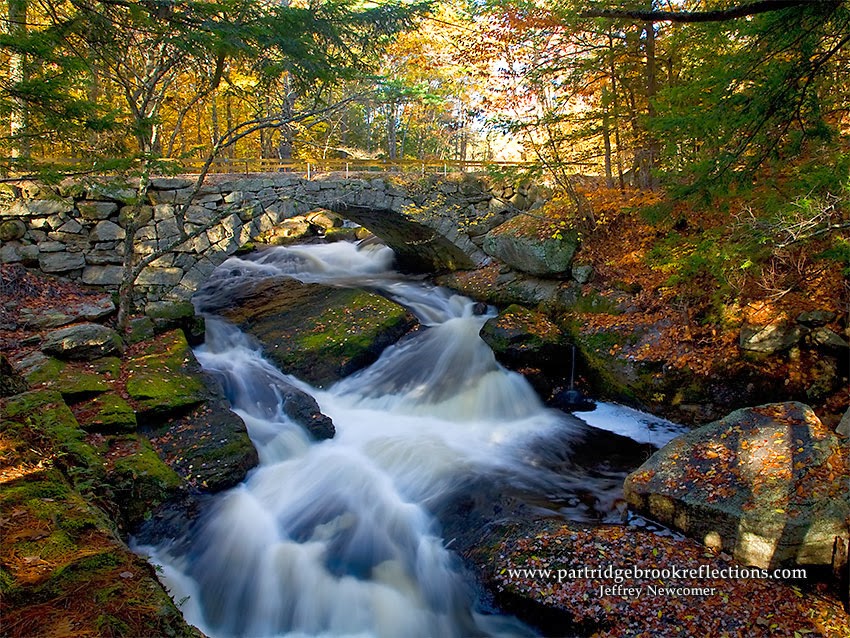

My partner and I stumbled over here coming from a different website and thought I may as well
ReplyDeletecheck things out. I like what I see so now i'm following
you. Look forward to exploring your web page again.오피